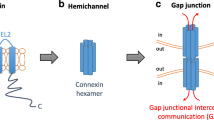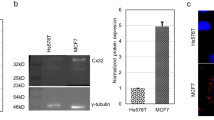Abstract
A considerable amount of evidence has established that gap junctional intercellular communication (GJIC) suppresses tumor development by halting the stage of tumor promotion. Consistently, GJIC is downregulated in tumors. The downregulation of GJIC is caused by not only the reduced expression level of connexin proteins but also their aberrant cytoplasmic localization. Although it has long been thought that cytoplasmic localization of connexin proteins is merely one of the mechanisms of the downregulation of GJIC, careful studies with human tumor samples have indicated that the expression level of intracytoplasmic connexin proteins correlates well with the grade of malignancy and the progression stage of tumors. Hypothesizing that intracytoplasmic connexin proteins should have their proper functions and that their increase should facilitate tumor progression such as cell migration, invasion and metastasis, we examined the effects of overexpressed connexin32 (Cx32) protein on the phenotype of human HuH7 hepatoma cells, which express a basal level of endogenous Cx32 only in cytoplasm. The cells were retrovirally transduced with the Tet-off Cx32 construct so that withdrawal of doxycycline from the culture medium could induce overexpression of Cx32 protein in cytoplasm. Even when overexpressed, Cx32 protein was retained in cytoplasm, i.e., Golgi apparatuses, and did not induce GJIC. However, overexpression of Cx32 protein in cytoplasm enhanced both the motility and the invasiveness of HuH7 cells and induced metastasis when the cells were xenografted into SCID mice. Taken together, cytoplasmic accumulation of connexin proteins may exert effects favorable for tumor progression.
Similar content being viewed by others
References
Ahmad S, Diez JA, George CH, Evans WH (1999) Synthesis and assembly of connexins in vitro into homomeric and heteromeric functional gap junction hemichannels. Biochem J 339:247–253
Diez JA, Ahmad S, Evans WH (1999) Assembly of heteromeric connexons in guinea-pig liver en route to the Golgi apparatus, plasma membrane and gap junctions. Eur J Biochem 262:142–148
Falk MM, Buehler LK, Kumar NM, Gilula NB (1997) Cell-free synthesis and assembly of connexins into functional gap junction membrane channels. EMBO J 16:2703–2716
Hendrix EM, Mao SJ, Everson W, Larsen WJ (1992) Myometrial connexin 43 trafficking and gap junction assembly at term and in preterm labor. Mol Reprod Dev 33:27–38
Hernandez-Blazquez FJ, Joazeiro PP, Omori Y, Yamasaki H (2001) Control of intracellular movement of connexins by E-cadherin in murine skin papilloma cells. Exp Cell Res 270:235–247
Ito A, Katoh F, Kataoka TR, Okada M, Tsubota N, Asada H, Yoshikawa K, Maeda S, Kitamura Y, Yamasaki H, Nojima H (2000) A role for heterologous gap junctions between melanoma and endothelial cells in metastasis. J Clin Invest 105:1189–1197
Ito A, Koma Y, Uchino K, Okada T, Ohbayashi C, Tsubota N, Okada M (2006) Increased expression of connexin 26 in the invasive component of lung squamous cell carcinoma: significant correlation with poor prognosis. Cancer Lett 234:239–248
Jamieson S, Going JJ, D’Arcy R, George WD (1998) Expression of gap junction proteins connexin 26 and connexin 43 in normal human breast and in breast tumours. J Pathol 184:37–43
Kanczuga-Koda L, Sulkowski S, Lenczewski A, Koda M, Wincewicz A, Baltaziak M, Sulkowska M (2006) Increased expression of connexins 26 and 43 in lymph node metastases of breast cancer. J Clin Pathol 59:429–433
Krutovskikh V, Mazzoleni G, Mironov N, Omori Y, Aguelon AM, Mesnil M, Berger F, Partensky C, Yamasaki H (1994) Altered homologous and heterologous gap-junctional intercellular communication in primary human liver tumors associated with aberrant protein localization but not gene mutation of connexin 32. Int J Cancer 56:87–94
Krutovskikh VA, Mesnil M, Mazzoleni G, Yamasaki H (1995) Inhibition of rat liver gap junction intercellular communication by tumor-promoting agents in vivo. Association with aberrant localization of connexin proteins. Lab Invest 72:571–577
Lauf U, Giepmans BN, Lopez P, Braconnot S, Chen SC, Falk MM (2002) Dynamic trafficking and delivery of connexons to the plasma membrane and accretion to gap junctions in living cells. Proc Natl Acad Sci USA 99:10446–10451
Leithe E, Sirnes S, Omori Y, Rivedal E (2006) Downregulation of gap junctions in cancer cells. Crit Rev Oncog 12:225–256
Li Q, Omori Y, Nishikawa Y, Yoshioka T, Yamamoto Y, Enomoto K (2007) Cytoplasmic accumulation of connexin32 protein enhances motility and metastatic ability of human hepatoma cells in vitro and in vivo. Int J Cancer 121:536–546
Loewenstein WR, Kanno Y (1966) Intercellular communication and the control of tissue growth: lack of communication between cancer cells. Nature 209:1248–1249
Loewenstein WR, Kanno Y (1967) Intercellular communication and tissue growth. I. Cancerous growth. J Cell Biol 33:225–234
Mehta PP, Perez-Stable C, Nadji M, Mian M, Asotra K, Roos BA (1999) Suppression of human prostate cancer cell growth by forced expression of connexin genes. Dev Genet 24:91–110
Mesnil M, Crespin S, Avanzo JL, Zaidan-Dagli ML (2005) Defective gap junctional intercellular communication in the carcinogenic process. Biochim Biophys Acta 1719:125–145
Momiyama M, Omori Y, Ishizaki Y, Nishikawa Y, Tokairin T, Ogawa J, Enomoto K (2003) Connexin26-mediated gap junctional communication reverses the malignant phenotype of MCF-7 breast cancer cells. Cancer Sci 94:501–507
Musil LS, Goodenough DA (1993) Multisubunit assembly of an integral plasma membrane channel protein, gap junction connexin43, occurs after exit from the ER. Cell 74:1065–1077
Nakabayashi H, Taketa K, Miyano K, Yamane T, Sato J (1982) Growth of human hepatoma cell lines with differentiated functions in chemically defined medium. Cancer Res 42:3858–3863
Omori Y, Duflot-Dancer A, Mesnil M, Yamasaki H (1998) Role of connexin (gap junction) genes in cell growth control: approach with site-directed mutagenesis and dominant-negative effects. Toxicol Lett 96–97:105–110
Omori Y, Krutovskikh V, Mironov N, Tsuda H, Yamasaki H (1996) Cx32 gene mutation in a chemically induced rat liver tumour. Carcinogenesis 17:2077–2080
Omori Y, Yamasaki H (1998) Mutated connexin43 proteins inhibit rat glioma cell growth suppression mediated by wild-type connexin43 in a dominant-negative manner. Int J Cancer 78:446–453
Oyamada M, Krutovskikh VA, Mesnil M, Partensky C, Berger F, Yamasaki H (1990) Aberrant expression of gap junction gene in primary human hepatocellular carcinomas: increased expression of cardiac-type gap junction gene connexin 43. Mol Carcinog 3:273–278
Sarma JD, Wang F, Koval M (2002) Targeted gap junction protein constructs reveal connexin-specific differences in oligomerization. J Biol Chem 277:20911–20918
Segretain D, Falk MM (2004) Regulation of connexin biosynthesis, assembly, gap junction formation, and removal. Biochim Biophys Acta 1662:3–21
Shaw RM, Fay AJ, Puthenveedu MA, von Zastrow M, Jan YN, Jan LY (2007) Microtubule plus-end-tracking proteins target gap junctions directly from the cell interior to adherens junctions. Cell 128:547–560
Trosko JE, Chang CC, Upham BL, Tai MH (2005) The role of human adult stem cells and cell–cell communication in cancer chemoprevention and chemotherapy strategies. Mutat Res 591:187–197
Yamasaki H, Naus CC (1996) Role of connexin genes in growth control. Carcinogenesis 17:1199–1213
Yano T, Hernandez-Blazquez FJ, Omori Y, Yamasaki H (2001) Reduction of malignant phenotype of HEPG2 cell is associated with the expression of connexin 26 but not connexin 32. Carcinogenesis 22:1593–1600
Acknowledgment
The authors gratefully acknowledge Ms. Reiko Ito, Ms. Yuko Doi and Ms. Makiko Kawamata for their technical assistance, as well as Ms. Eriko Kumagai for her secretarial work. Q. L. is a recipient of a Japanese government (MEXT) scholarship (022101).
Author information
Authors and Affiliations
Corresponding author
Rights and permissions
About this article
Cite this article
Omori, Y., Li, Q., Nishikawa, Y. et al. Pathological Significance of Intracytoplasmic Connexin Proteins: Implication in Tumor Progression. J Membrane Biol 218, 73–77 (2007). https://doi.org/10.1007/s00232-007-9048-6
Received:
Accepted:
Published:
Issue Date:
DOI: https://doi.org/10.1007/s00232-007-9048-6




